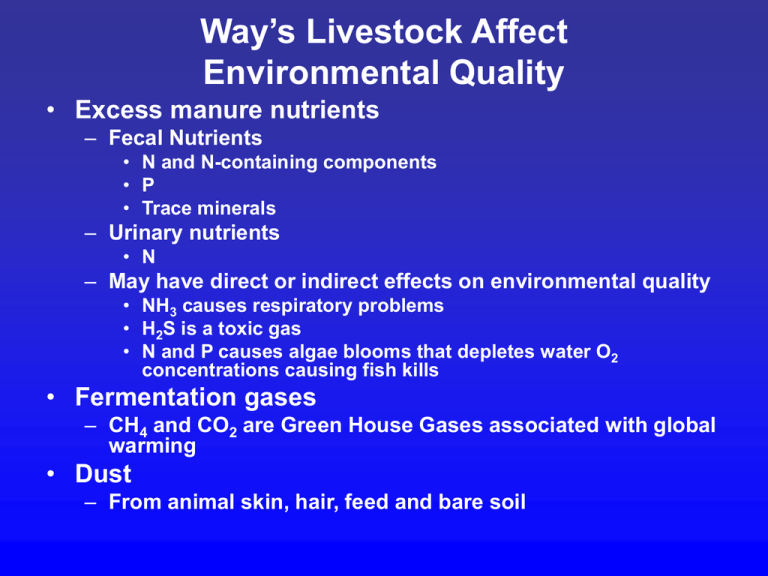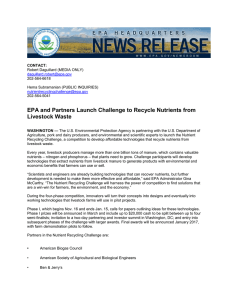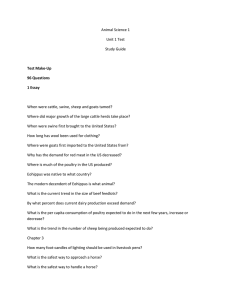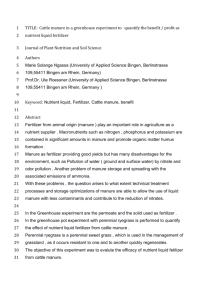Way’s Livestock Affect Environmental Quality Excess manure nutrients Fermentation gases
advertisement

Way’s Livestock Affect Environmental Quality • Excess manure nutrients – Fecal Nutrients • N and N-containing components • P • Trace minerals – Urinary nutrients • N – May have direct or indirect effects on environmental quality • NH3 causes respiratory problems • H2S is a toxic gas • N and P causes algae blooms that depletes water O2 concentrations causing fish kills • Fermentation gases – CH4 and CO2 are Green House Gases associated with global warming • Dust – From animal skin, hair, feed and bare soil • Pathogens – May be direct from manure deposition and runoff or endotoxins in air within confinement buildings – May be indirect from N and P • Endocrine disrupters • Animal Mortalities – Contributes N, P, gases, pathogens, and bad aesthetic quality • Pasture erosion – From upland and riparian areas • Loss of biodiversity – Directly from selective grazing – Indirectly from nutrient imbalance • All effects are manageable with good management Use of Nutrient Balance to Control Environmental Problems Associated with Livestock Problems with Managing Livestock for Environmental Quality • Structure of agriculture • Regulations are rapidly changing • Lack of meaningful measurements of performance • Inadequate technologies • Solving one environmental problem can cause other problems • Controlling environmental quality requires more and different management • Economic costs INTEGRATED BEEF AND CROP PRODUCTION IN A BIOFUEL ERA Ethanol & Biodiesel Nutrients Coproducts Nutrients Energy Products Crops Livestock Manure Nutrient and energy losses Environmental damage Regional border Problems with Managing Livestock for Environmental Quality • Structure of agriculture • Regulations are rapidly changing • Lack of meaningful measurements of performance • Inadequate technologies • Solving one environmental problem can cause other problems • Controlling environmental quality requires more and different management • Economic costs • • • • • Why Manage Livestock for Environmental Quality? To meet governmental regulations To meet specifications set by food retailers or niche market programs Reduce offsite costs of environmental damage To avoid conflicts with neighbors and community Can be a win-win situation – Balancing diets will reduce feed costs – Proper manure application will reduce fertilizer costs – Improved grazing management will increase production while improving pasture stream water quality – Marketing advantage Problems with Managing Livestock for Environmental Quality • Confounding of environmental goals with social, economic, animal welfare or aesthetic goals • Problems of denial by some producers and groups in livestock production – Arguments that are not positive inhibit progress and increases conflicts – Need to consider the perspectives of consumers • Regulations are rapidly changing – More is learned about the relationship between environmental health and human health – General public in U.S. and other countries are calling for more environmental protection – Conflicting and emerging science on the effects of livestock on the environment • Measurement of nonpoint source pollution is difficult and often inaccurate. – Atmospheric NH3 is measured on an air-shed basis – Sediment and P entering pasture streams primarily occurs during storm events and is confounded by upstream management practices – Manure odor is composed by as many as 300 odors • Solving one environmental problem can lead to another – Injection of manure into the soil reduces NH3 volatilization, odors and P loss, but may increased dissolved NO3 and P in ground water – Increasing N fertilization increases forage production, but decreases biodiversity – Implications: • Must think holistically • To limit nutrient excretion, diets must be accurately blended to meet animal requirements, but: – Exact nutrient requirements for many species at different sizes and sexes are not accurately known • Most nutrient requirements have been set with safety margins above the physiological functions Production Production/animal Excretion Nutrient consumed • Diets balanced for environmental management may have some risk for reduced performance, but don’t necessarily have to • Common feedstuffs contain imbalances of various nutrients – Grains contain high concentrations of P – Legume forage contain high concentrations of protein that is highly degradable in the rumen of cattle • Rapid measurement of many feed microingredients are difficult, expensive, or nonexistent • Composition of manure is variable – Crop producers prefer using fertilizer nutrients • Controlling environmental quality requires more management – It’s easier to feed a single group of animals than groups of animals separated by sex and size – It’s easier taking a trace mineral block out to a cowherd than to calculate whether they need it – Its easier just applying fertilizer than analyzing and calibrating manure application • Structure of Agriculture – 50% of the corn produced in NE leaves the state – Farms that produce more manure than can be safely applied at the agronomic rate account for: • 60% of the nation’s manure N • 70% of the nation’s manure P • Measure to manage livestock to maintain environmental quality will have an economic cost – If the number of animals per acre are limited, operations may be too small to be economically viable – Measures like diet manipulation or improved manure handling, storage and application will likely have economic costs – Who pays? • Government • Consumers • Producers







